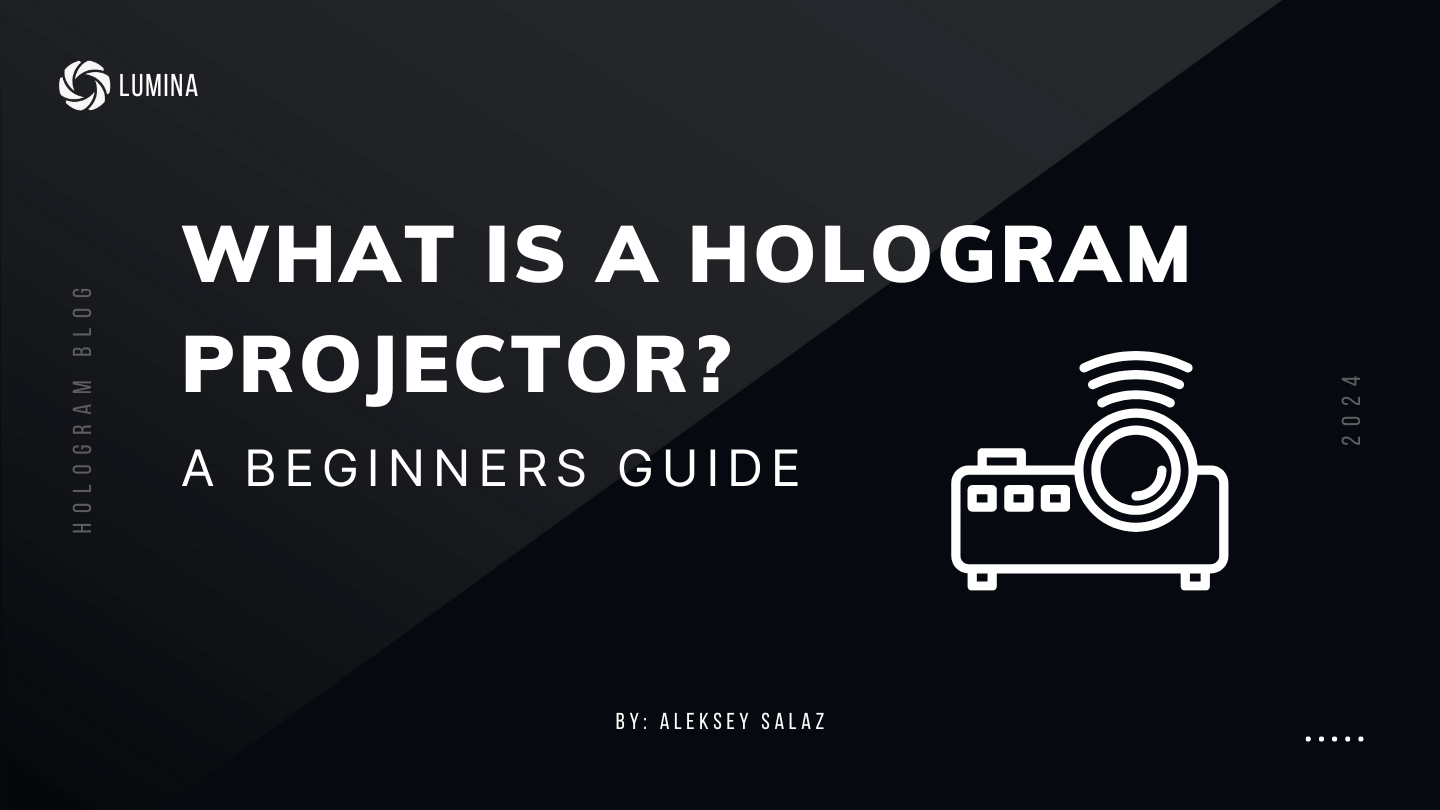Curious about types of hologram projectors?
You'll learn about fan projectors for eye-catching advertising, immersive head-mounted models, and the fun of DIY holograms. Each type has its own place in education, entertainment, and marketing, with unique pros and cons.
Ready to dive in? Let's start with handheld hologram projectors – these portable wonders offer a world of 3D technology in the palm of your hand.
Key Takeaways
-
Versatile Uses: Hologram projectors vary in type, each suited for different uses. Handheld projectors are great for personal learning and fun, while tabletop models enhance group activities. Hologram fans are ideal for advertising, and head-mounted versions offer immersive experiences. Large-scale projectors make big impressions at events.
-
Pros and Cons: Each projector type has its benefits and drawbacks. Portability, interactive learning, and immersive experiences are key advantages. However, they face challenges like limited display size, battery life, and higher costs.
-
Innovation and Fun: These projectors showcase technological advances, creating stunning 3D images. They're not just for display; they open up new possibilities for education, entertainment, and creativity.
Handheld Hologram Projectors
Welcome to handheld hologram projectors! These small devices are full of surprises:
Compact and Powerful
They fit right in your hand, perfect for travel. Each projector boasts high-resolution displays. This means you see clear, bright 3D images wherever you go.
Learning and Fun
In classrooms, they bring subjects like science to life. Students can explore 3D models of planets or molecules. For fun at home, they turn movies and games into 3D adventures.
Changing Education and Entertainment
These projectors make learning interactive and fun. Imagine studying the human body in 3D! They also bring a new dimension to watching movies and playing games.
Cons of Handheld Hologram Projectors
- Smaller Display Size: The holograms they project are relatively small, limiting the scale of the display.
- Limited Battery Life: Being portable, they rely on batteries, which may not last very long and require frequent recharging.
- Lower Resolution: Compared to larger projectors, the image quality might not be as sharp or detailed.
Handheld hologram projectors are not just gadgets; they're gateways to a New world of learning and fun.
Tabletop Hologram Projectors
Next up are tabletop hologram projectors! Here's why they're cool:
Perfect for Groups
These projectors are bigger than handheld models. They can sit on a table and project larger holograms.
This makes them awesome for group activities, like in a classroom or a family game night. Everyone can see the 3D images clearly, making learning and playing together more fun.
Educational Powerhouses
They're fantastic for schools. Teachers can use them to show big 3D models of things like the human heart or the solar system. It's like having a 3D movie in class!
Entertainment for Everyone
These projectors are also great at home. They can turn movie nights or gaming with friends into a 3D experience. Imagine watching your favorite characters in 3D right on your dining table!
Cons of Tabletop Hologram Projectors
- Space Requirements: They need a good amount of table space, which might not always be available.
- Less Portable: Unlike handheld projectors, moving these around can be a bit of a hassle.
- Higher Price Point: They usually cost more than smaller models, making them a bigger investment.
Tabletop projectors make group experiences more interactive and enjoyable, whether it's learning in class or having fun at home.
Hologram Fans
Let's explore hologram fans! They are awesome for displaying 3D images:
How They Work
Hologram fans use LEDs on spinning blades. When they spin fast, they create floating images. It's like seeing a movie in the air!
Perfect for Attention
- Great for Business: Stores use them for eye-catching ads. You might see a 3D shoe or phone floating in a shop window.
- Events and Shows: They're also big hits at events. Imagine seeing a 3D logo or mascot floating above a crowd.
Setting Them Up
- Easy Installation: They're super easy to hang and start. Just plug them in and watch the magic happen.
- Safe and Convenient: They're also safe to use. Most have protective covers and remote controls.
Cons of Hologram Fans
- Limited Viewing Angles: The 3D effect might not be as good from certain angles.
- Requires Specific Lighting: They work best in dim or dark environments.
- Noise Factor: The spinning can be a bit noisy, which might be distracting in quieter settings.
Hologram fans bring a wow factor anywhere, from stores to events, with their cool 3D floating images.
Head-Mounted Hologram Projectors
Welcome to the world of head-mounted hologram projectors! These devices are a gateway to virtual worlds:
3D Experiences
Virtual Reality at Its Best: Learn how these projectors transport you to different worlds. From games to virtual tours, they offer a full 3D experience that surrounds you completely.
Technology Behind the Scenes
How It Works: Discover the amazing technology that makes these 3D experiences possible. It's a mix of motion tracking, advanced optics, and interactive software.
Using Head-Mounted Projectors in Education and Gaming
Learning Made Fun: See how these devices make education interactive. They can take students on virtual field trips or help them learn complex subjects in a fun way.
Gaming Revolution: Gamers love these projectors! They make games more realistic and engaging. Imagine being in the game world, not just playing it.
Comfort and Convenience
User-Friendly Design: These projectors are designed for comfort. Find out how they fit different head sizes and shapes, ensuring everyone can enjoy the experience without discomfort.
Easy to Use: Learn how simple it is to set up and use these projectors. They're user-friendly, so you can start exploring virtual worlds in no time.
Challenges and Considerations
- Getting Used to It: Some people might feel a bit dizzy or weird at first. It's like getting your sea legs but in a virtual world.
- Battery Life: These gadgets need charging. Sometimes, they might not last as long as you want them to in one go.
- Cost Factor: They can be a bit pricey. Saving up for one might take some time, but many think it's worth it.
Large-Scale Hologram Projectors
Get ready for the giants of the hologram world – large-scale projectors!
Making Huge Impressions
- Giant 3D Wonders: Picture a massive hologram of a famous singer at a concert. These projectors make such jaw-dropping displays possible.
- Tech Magic: They use really cool tech to make big, clear images. It's like seeing your favorite characters come to life, life-size!
Perfect for Big Moments
- Event Superstars: Imagine a 3D dragon flying over a festival. These projectors can turn any event into a magical experience.
- Ads That Amaze: Big ads need big impact. A giant floating sneaker or smartphone in the air? That's sure to grab attention.
Challenges Of Large-Scale Projectors
- Space Needed: They're great but big. You need lots of room to set them up.
- Budget Matters: They can be expensive. But for a big event, they're often worth the cost.
These large-scale projectors bring fantasy to life, perfect for making any event or advertisement unforgettable. Just remember, they need space and can be pricey!
DIY Hologram Projectors
Explore the fun world of DIY hologram projectors!
Crafting Your Own Hologram Magic
- Homemade Holograms: Learn how to make your own projector with simple materials like plastic sheets and a smartphone. It's a cool weekend project!
- Creative Ideas: You can project anything from a mini dancer to a floating planet. The possibilities are endless and super fun.
Great for Learning and Fun
- Educational Projects: Perfect for school science fairs or learning about optics and light.
- Entertainment at Home: Impress your friends and family with a homemade 3D show right in your living room.
Challenges in DIY Projectors
- Getting it Right: It might take a few tries to get your projector working perfectly.
- Limited Size: These projectors are smaller and less powerful than professional ones, but still amazing!
Making your own hologram projector is an exciting way to learn and have fun with technology. You might face some challenges, but the result is worth it!
Comparing Thin Anatomical vs. Thick Volumetric Holograms
Let's compare two cool types of holograms:
Thin Anatomical Holograms
- Super Detailed: These holograms are like high-def TVs for 3D images. They show very detailed stuff, like the parts inside the human body.
- Medical Marvels: Doctors love them for looking at organs without surgery. They're also great for teaching students about the body.
Thick Volumetric Holograms
- Big and Bold: These are the 3D heavyweights. They can show big stuff, like an entire engine or a life-size animal.
- Real-Life Feel: They're awesome for making things look real and touchable. Museums and designers use them to show objects in true 3D.
Both types are amazing in their own ways. Thin ones are great for details, and thick ones make big things feel real.
Types of Holograms
Here's a look at different types of hologram projectors:
Fan-Based Projectors
- Cool Visuals: These use spinning fans with LED lights. They create floating 3D images, perfect for ads or cool displays.
- Widely Used: You'll see them in stores or at events, showing off products or logos in a unique way.
Pepper's Ghost Projectors
- Classic Trick: An old technique with mirrors and lights. It makes things look like they're floating in space.
- Used in Shows: Great for concerts or theater, adding a ghostly or magical touch.
Laser Holography Projectors
- High Tech: These use lasers to make super clear and bright 3D images.
- For Detail Lovers: Perfect for when you need really detailed visuals, like in art or scientific displays.
Each type has its own cool features. From floating ads to magical shows, hologram projectors make everything more exciting!
Hologram Components
Let's break down what makes up a hologram projector:
- Light Source: Every hologram projector needs a light source. This is usually a laser or LED. It provides the light that creates the hologram.
- Spatial Light Modulator (SLM): This part controls the light. It works like a really advanced screen, shaping the light into 3D images.
- Mirrors and Lenses: These help direct the light where it needs to go. They focus the light to make the hologram clear and sharp.
- Projection Surface: Some holograms project onto a surface. This could be a screen, mist, or even thin air!
Understanding these components helps us see how holograms turn light into amazing 3D images. It's like a magic show of light and technology!
Wrapping Up
We've journeyed through the exciting world of hologram projectors. From the palm-sized wonders of handheld projectors to the awe-inspiring displays of large-scale models, each type has its own unique charm.
We discovered how fan projectors create mesmerizing ads, how head-mounted devices take us to virtual realms, and even how to make our own hologram projectors at home!
While each type has its pros and cons, one thing is clear: hologram projectors bring a touch of magic to our world. They're not just tools for display; they're gateways to imagination and learning. So, whether you're a tech enthusiast, a teacher, or just curious, there's a hologram projector for you.


